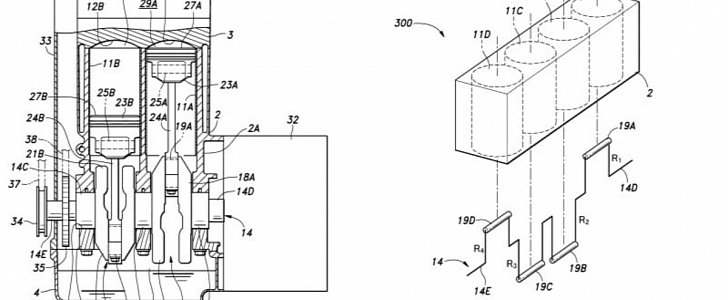Honda patented an innovative engine back in 2014, and the automaker has now received the rights to it.
The patent was then published on Japan’s Patent Office website, but it is no longer accessible. Fortunately, the guys at Autoguide managed to snatch it before it was concealed for several more years, until Honda officially unveils something based on it.
So, let’s get to business. The idea behind this new engine design is to implement a variable displacement using the same bore, but a different stroke. Since nobody has invented an electronically-controllable piston rod, Honda’s engineers came up with an innovative crankshaft design.
The new concept allows engineers to build an engine with different cylinder capacities, an unmatched feat in the automotive industry. Instead, variable displacement engines have been used before and are available on production cars, but they work by turning off cylinders.
Honda looks like it will also employ cylinder deactivation, but the combination of cylinder capacities will allow the Japanese automaker to provide multiple displacement combinations depending on the chambers it will operate for every combustion cycle.
If you are not impressed yet, Honda’s latest engine design patent works both on inline engines and on V6 units (or other V-type configurations). Thanks to this innovation, Honda might employ a V4, V6, or V8 unit with a variable displacement, all with the same technology that it can use on its inline-four or inline-three engines.
Let’s remember that Honda also builds motorcycles, where both V-Twin and V4 configurations are used, while inline-two and inline-four configurations have been employed over the years. Having owned an inline-four Honda motorcycle with an impressive power-to-output ratio, I can only dream of what they could build with this technology.
Honda did not disclose the purpose of this new engine design, but we suspect it will be used to increase efficiency and fuel economy. It might be Honda’s answer to downsizing, and the automaker could employ naturally aspirated units for these new power plants.
So, let’s get to business. The idea behind this new engine design is to implement a variable displacement using the same bore, but a different stroke. Since nobody has invented an electronically-controllable piston rod, Honda’s engineers came up with an innovative crankshaft design.
The new concept allows engineers to build an engine with different cylinder capacities, an unmatched feat in the automotive industry. Instead, variable displacement engines have been used before and are available on production cars, but they work by turning off cylinders.
Honda looks like it will also employ cylinder deactivation, but the combination of cylinder capacities will allow the Japanese automaker to provide multiple displacement combinations depending on the chambers it will operate for every combustion cycle.
If you are not impressed yet, Honda’s latest engine design patent works both on inline engines and on V6 units (or other V-type configurations). Thanks to this innovation, Honda might employ a V4, V6, or V8 unit with a variable displacement, all with the same technology that it can use on its inline-four or inline-three engines.
Let’s remember that Honda also builds motorcycles, where both V-Twin and V4 configurations are used, while inline-two and inline-four configurations have been employed over the years. Having owned an inline-four Honda motorcycle with an impressive power-to-output ratio, I can only dream of what they could build with this technology.
Honda did not disclose the purpose of this new engine design, but we suspect it will be used to increase efficiency and fuel economy. It might be Honda’s answer to downsizing, and the automaker could employ naturally aspirated units for these new power plants.

